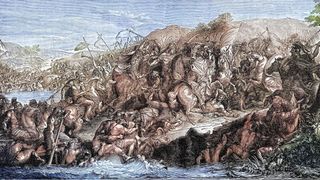Alexander the Great Who Converted to Christians and Changed it to Its Will
Alexander the Great modern painting. he was Strong, Young and as Gay as 'me' under today's standards. he Love men and they did not have to be strong looking like him. I think Christians should know what those that know history know. Who was your daddy? (for latter0
This posting referrers to the finding of the site of Alexander's Battle of The Granicus. If unlike me you not into History, I understand but the reason Im using this piece of news to reintroduce my readers to Alex. WHY?
Because unlike of what the Vatican has said which has cost many lives, yes they call it Martyrs. Alexander the Great heard about a large group of Christians. They were guideless and interpreted words of Jesus C Christ differently from each other since what they had was word of mouth and letters discovered from Paul to the Corintians and others. He figured they are hungry for guidance, help and a king, which would be Alexander. In those days when the person in charge (king or Queen) wanted something other than was done by Porcclamtion, you know like the little guy named Putin. Putin loves doing declarations just like a king.. The difference within the two was then Alexander said he was converted and now the religion was to be Christians. Immediate conversation for all or Death! If you disagree you were a heretic and you know what happened to them. This was the beginning of the Christian Church. It wa also the beginning of the crusades that History ignorant Pastor like to Preach. The crusades went to other countries to save them and while at it cover them to Christianism. That was the beginning of the religion taking hold by force in Europe and the Near East. hat was the fasted was the fastest way to get something done. It just got many killed.Religion is an indoctrination that starts with the parents directing the kids to follow their god. So just like now, people born in. the church ev en if they leave they come back. As soon as aa car accident or cancer hits the family they are over asking for prayer. It shows how self consuming and self's humans ten to be.
I'll stop here and instead gives you smaller portions that so we can keep up with whats going on. I don't want to make this site Sunday school morn class. (that was a joke).
The beginning of the Christian Church was Alexander the Great. Without him this little religion would HAVE BEEN TERMINATED AS HERETICS. Adam Gonzalez
A colorized engraving of Alexander the Great fighting at the Battle of the Granicus. (Image credit: mikroman6 via Getty Images)
Researchers believe they have found the site where Alexander the Great's troops fought the Battle of the Granicus.
Researchers may have finally identified the site where Alexander the Greatfought the Battle of the Granicus against the Persian Empire.
The site is about 6 miles (10 kilometers) north of the city of Biga in northwest Turkey. In 334 B.C. Alexander's forces defeated the Persians at the battlefield, which enabled them to establish a foothold in Persian territory and push deeper into the Middle East.
"The Battle of Granicus was not only one of the most significant turning points in Alexander's life, later earning him the epithet 'the Great,' but [was] also a pivotal moment in world history," team leader Reyhan Körpe, an archaeology professor at Canakkale Onsekiz Mart University, told Live Science in an email. The discovery is not entirely new. Körpe noted that Heinrich Kiepert, an archaeologist who worked in the region in the 19th century, had suggested that the same area could be the location of the battlefield. But Körpe's team has now uncovered additional evidence supporting the suggestion.
Notably, the team identified the remains of the ancient city of Hermaion, which ancient records indicate was the location of Alexander's last encampment before the battle. The researchers then conducted geomorphological tests to reconstruct what the nearby landscape looked like when the battle was fought. They found that the path of the Granicus River had changed little since Alexander's time. They also found that some areas were marshy in Alexander's time and therefore don't match the description of the battlefield, enabling the team to rule out these locations.
Related: What if the Persians had defeated Alexander the Great? Ancient records say that Alexander stationed Persian Greek mercenaries on a hill, and the team identified a promising hill site where local farmers had found graves with weapons that may date to Alexander's time. For example, in 2024, farmers uncovered the remains of human bones during plowing near the southern slope of the hill. The researchers examined the bones and found that they are from an adult male. STORIES
"The lack of typical grave markers or artifacts indicated these were not part of a formal cemetery," Körpe said. However, more tests need to be done to determine when this individual dates to and how they died.
Live Science contacted scholars not involved with the researchers to get their thoughts. Graham Wrightson, a history professor at South Dakota State University, said that the team's finds are interesting. "It is exciting that they believe it has been identified," Wrightson told Live Science in an email. "We'll have to wait more years now to see what artifacts come out of the annual digs."
Körpe said that the team plans to conduct geophysical surveys and excavations to get a better idea of what lies beneath the ground


Comments